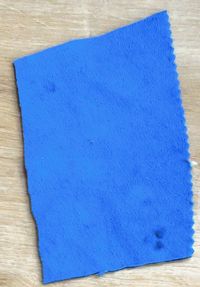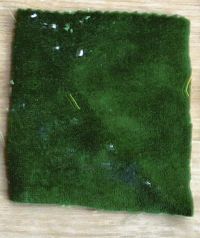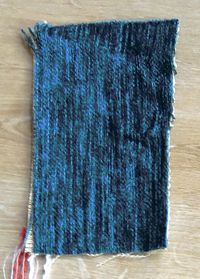How to define fabrics composition out of creator stock without label ?
On the leftovers fabrics, 4 fabrics still had a label mentioning their composition:
- 3 cotton and linen rolls
- 1 cotton and polyester
The other compositions are not known.
Burning test¶
In order to define the composition of the tissues there is a burning test which consists in burning a piece of tissue and seeing its reaction to fire in order to define characteristics.
In addition to this combustion test, the visual and the tissue touch will be studied.
The combustion test can be carried out on fabrics in order to know their composition
How to do a burning test ?
To do a burning test, you'll need to take a small piece of fabric and burn it with a lighter.
Proceed carefully, and stay close to a water point.
Once the fabric is burning watch carefully how the fabric reacted, flame, smoke, odor, and residues, and compare the results to the following list :
| Material | Flame | Smoke | Odor | Residues | Reaction | Laser cut |
|---|---|---|---|---|---|---|
| Cotton | Easily flammable, round flame, yellow flame | Gray or white | Papery smell | Dark gray, can be easily crush, ash | Continues to burn if flame removed | Yes |
| Linen | Burn quickly with a yellow flame | White | Burning paper or rope | Soft grey ash | Easily extinguished by blowing on it | Yes |
| Rayon | Easily flammable, yellow round flame | no smoke | Papery smell | Light gray | Continues to burn if flame removed | Yes |
| Acrylic | Shrinks quickly, melt and burns slowly | Black | Chemical smell (acidic) | Yellow-brown hard, irregular shape | Continue to burn if flame is removed | Yes |
| Polyester | Shrinks quickly, melt and burns slowly | Black | Chemical smell round (similar to burned plastic) | Hard, melted black beads | Self extinguished if flame removed | Yes |
| Nylon | Shrinks quickly, melt and burns slowly | Black | Celery like smell | Round, hard, melted black beads | Small bubbles when burning. Continue to burn if flame is removed | Yes |
| Silk | Burn slowly | No smoke | burning hair | crushable black beads of ash | curl away from the flame, self extinguish | Yes |
| Wool | Burn slowly | burning hair or feather | brittle beads, black ash | Curl away from the flame, self extinguish | Yes | |
| Acetate | Burn slowly and melt | Black smoke | Vinegar | hard, black beads | Continue to burn if flame is removed | No |
| Hemp | Burn quickly, bright flame | No smoke | Burning leaves or wood | Gray ash | Yes | |
| Jute | Burn quickly, bright flame | No smoke | Burning leaves or wood | Gray ash | Do not shrink from flame | Yes |
| PVC | Yellow flame with green spurts | Smell like hydrochloric acid | Self extinguish | No |
| Photos | Burning test results | Fabric type |
|---|---|---|
 |
Yellow flame, dark smoke, quick combustion, black beads, plastic smell, continue to burn | Nylon |
 |
Continue to burn, smell like burning hair, black bead | Silk |
 |
Yellow flame, slow combustion, beads, plastic smell | Nylon |
 |
Yellow flame, black smoke, quick combustion, black beads, plastic smell | Polyester velvet |
 |
Yellow-orange flame, white smoke, continue to burn, still incandescent, black ash | Cotton velvet |
 |
Yellow flame, papery smell, continue to burn, quick combustin | Cotton and linen |
 |
Yellow flame, papery smell, still burning, still incandescent, ashes | Cotton and linen |
Beilstein test¶
Fabrics and materials that contains chlorine should not be lasercut as it is producing toxic emanation that could be dangerous for the health of people.
The Beilstein test is used to determine if a material contains chlorine and could be also used with unknown fabrics before lasercutting.
"Use a copper wire thick enough not to melt too quickly. Heat the copper wire to glowing red in the flame of a Bunsen burner or propane torch.
Continue heating until no colour (other than the nearly invisible, slightly blue torch flame) is visible. There should be no green colour in the flame. Wash the wire intermittently with water and dilute nitric acid (10%) to remove materials that cause unwanted colouration. If washing fails, try a new wire. Once it is clean, take care to avoid touching the wire with fingers or objects other than the test material. When the flame is colourless, the test can proceed.
The test is best carried out in subdued lighting so that the colour of the flame can be seen easily. Vapours, fumes, or smoke from the sample must envelop the hot copper wire in the flame so that reactions between the tested material and the hot copper can occur.
Heat the wire to red-hot, then quickly touch a fragment of the sample to it and immediately return the wire to the flame. A plume of green is a positive test for the presence of chlorine."
References¶
In order to know how to recognize fabrics with the burning test I've done some research and combined the research results in order to have all the different fabrics type. The two firsts sources are articles and research on fabric identification, the third one does not have any references and should be used with precaution.